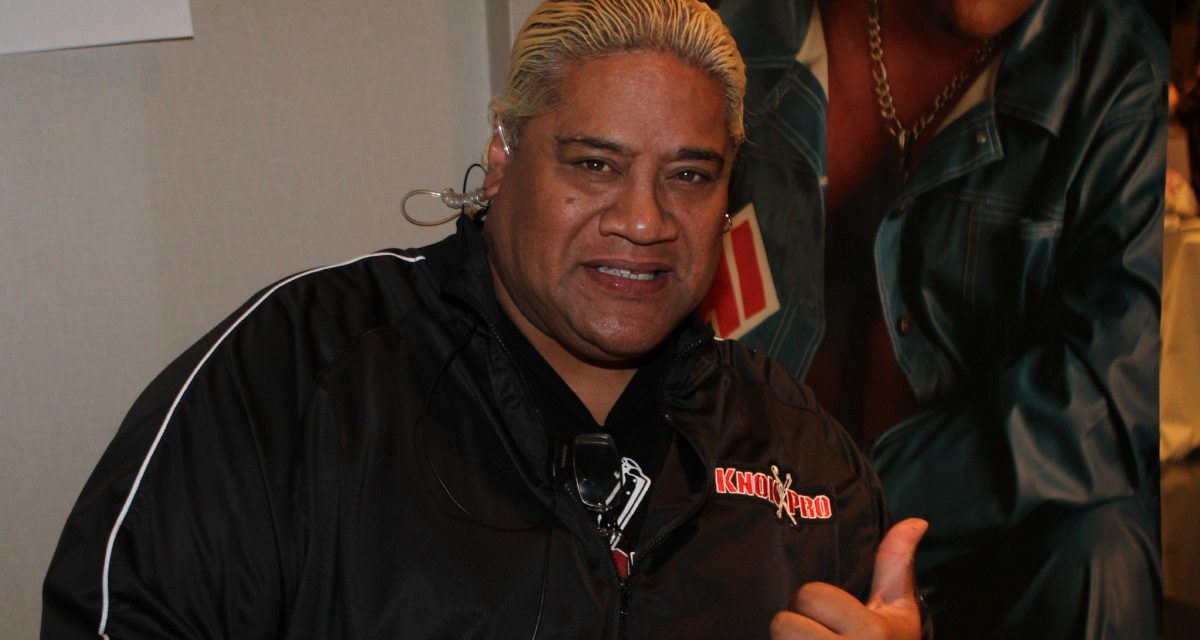The name Rikishi conjures up images of hapless wrestlers caught in a precarious position. Just when everything seems to be going wrong when facing Rikishi it can get much worse when he shoves his ample rump into his opponents face. Rikishi hasn’t always been shoving his posterior into the snots of foes, in fact Solofa Fatu Jr. started on the undercard as a rookie trying to make a name for himself in the wrestling business.
After being trained for the ring by his uncles, Afa and Sika the Wild Samoans, young Rikishi travelled to his first territory in 1985. “My career started actually in Montreal,” said Rikishi. “Number one, I was a young kid at the age of 18 very blessed to break in to Montreal. It was a great opportunity.”
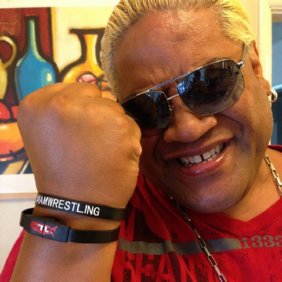
A recent photo of Rikishi at a fan fest. Courtesy Rikishi’s official Facebook page
The Montreal territory covered large portions of Quebec including places in Ontario such as Ottawa and Sudbury. In fact television coverage for the Montreal territory was so good that it covered most of Eastern Canada and even extended into southern Ontario.
Rikishi entered the promotion under the name Prince Alofa. At that time he was agile in the ring and often used high flying maneuvers throughout his matches. “It was a great opportunity,” recalled Rikishi prior to a Crossfire Wrestling show in St. Catharines, Ontario. “At the time it was being run by Dino Bravo, Rick Martel, Eddie Creatchman, and I was there with my cousin Samu. As a young kid I was in there paying my dues in the territory.”
When asked about his time in his first wrestling territory Rikishi felt thankful for the experience. “I really, really liked it in Montreal,” said Rikishi. “It was a different vibe; I was working almost every night out there. I got to learn from the ground on up from the best of the best in the business.”
A unique aspect of the Montreal territory was that the province of Quebec is a predominately French-speaking area and Rikishi was definitely not fluent in French. He smiled at the memory. “They knew some English and at the time I learned to speak a few French words out there,” said Rikishi. “They were kind people. I was a babyface out there, a young kid, and adapted very well with the people out there.”
The young Rikishi loved learning from other wrestlers while on the road heading to the next town. “I learned a lot from being on the road with guys like Dino Bravo, Rick Martel, the Creatchmans here in Canada,” said Rikishi. “Just the way that they teach you about the way of the business, of how the business works. As a young kid we all learn. I find out that I learned a lot from those who paved the way in wrestling. It helped me out with my career.”
After his run ended in Montreal Rikishi and his cousin Samu formed a tag team known as the SST or the Samoan Swat Team. The duo had a brief run in Puerto Rico before heading to Texas for World Class Championship Wrestling (WCCW). In Texas, Rikishi, then known as Fatu, and Samu were developing their style, timing and move set for their team. “You were working every day, doing TV, which taught us to be in front of a TV crowd, working the TV type of matches,” recalled Rikishi. “We were more busy with Von Erichs, again Texas was a big territory. It was really our first time to be out there and be showcased worldwide.”
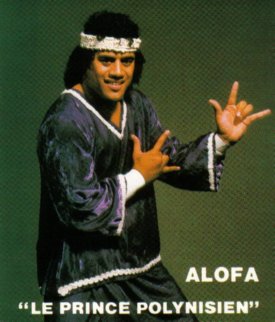
He was a Polynesian Prince known as Alofa in Montreal. Photo by Linda Boucher.
The WCCW wrestling show was syndicated on ESPN and other outlets around the world. “We were really thankful for the opportunity there,” said Rikishi. “Being in different territories was really a way for us to find any type of bookings. As a young kid you were just worried, your main concern was just getting booked. You took any bookings you could. It wasn’t about the money, it was about us getting our name out there and paying your dues.”
On December 13, 1988, the Samoan Swat Team was pegged to participate in their first pay per view, Super Clash 3 in Chicago, Illinois. The show was promoted by the AWA, and the last of the viable wrestling territories sent their stars to help boost the show. That night the SST defeated Michael Hayes and Steve Cox when Samu pinned Hayes.
While Rikishi recalled the event as another step on the road of his career he did not seemed overwhelmed by it. “With that deal there I was in Texas,” said Rikishi. “During that time I got booked through the Von Erichs they were actually kinda working with that company the AWA. Anytime we came on their show it was through Texas out there, that’s how that happened out there.”
After Texas the Samoan Swat Team travelled to World Championship Wrestling and they came up against some stiff competition. Tag teams such as the Midnight Express, the Road Warriors, the Steiner Brothers, the Skyscrapers, and the Freebirds helped the young duo to elevate their game to a new level.
“It helped me out a lot with my career learning how to work with such different and great tag teams such as the Road Warriors taught us how to turn our game into powerhouses,” said Rikishi. “When you’re working against the Steiner Brothers, there’s a tag team that likes to work snug, tight. Sometimes shoot in there, but in a happy way. It turned our game to adapt to different styles. When you work with the Freebirds they are the entertainment of entertainment teams. Working with Michael Hayes, Buddy Roberts, and Terry Gordy; we learned so much from working with those guys there to adapt to being an entertainer. With the three different tag teams like that what I can take from that, my advice to teams out there is you learn to adapt to certain tag teams.”
The veteran teams of WCW helped to mold the rising SST. Rikishi credits his opponents in those years as the ones who molded his young team. “We took a piece from every tag team and that helped find SST and the Headshrinkers and we utilized that with the training of our uncles Afa and Sika,” said Rikishi. “Those were big shoes to fill, you know? With all that you kind of find your way. I was very grateful to learn from such great tag teams. Any time you work with great teams like that and even young teams coming up you are still learning. There are things like moves you see from a young team that you don’t from teams that are established such as the Freebirds. There is always the little things that you can take from each tag team to be able to find yourself.”
After leaving WCW in 1990, Rikishi travelled to the UWA in Mexico. Here was another chance to learn along the way and to wrestle some of the world’s finest grapplers. “Early on in my career I used to go to Mexico,” Rikishi reflected. “I was booked out there with the late, mighty Yokozuna, the late Owen Hart, the late Chris Benoit. So we come in to do two week tours at a time. They would bring the Samoans in and our last day they would bring in Chris Benoit and Owen Hart.”
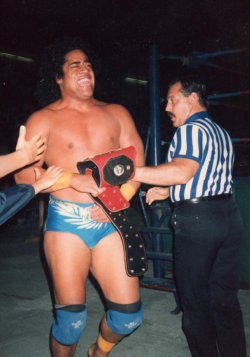
A young Alofa with one of the International Wrestling tag team belts in Montreal. Photo by Linda Boucher.
At times he found the conditions in Mexico to be problematic. Sometimes the venue would be terrible, or the locker room would be a pen for cattle, or worse. “My experience was the first time I was out there we were in this dressing room and when you are young you aren’t paying no mind and are just excited to be on this show,” said Rikishi with a grin. “We were in the dressing room and walked in. It smelled so bad, it smelled like bull crap. I looked around at all the other wrestlers and it was like normal to them so I thought maybe it was just the smell of where we at.”
A smelly locker room might not be so bad if it hadn’t been accompanied by a scene out of a horror movie. “I was sitting there and all of a sudden I could see blood dripping,” said Rikishi. “I looked up and I seen a bull head. They must have slashed him open and killed the poor thing. We were actually dressing in a bull arena right there where we had all the bulls at — it was the weirdest thing. We were right by bull manure. It was a lesson to be learned. I was a young kid and I thought this is the beginning of what wrestling is. I remember calling my uncle and said, ‘Man this is horrible.’ He said, ‘Smarten up, this is pro wrestling. Learn to adapt. Not every arena is beautiful. Just get out there and do your time and go take a shower at the hotel.’ After that there could be nothing worse than that. Every other arena was just sweet.”
In 1992 the WWE signed Samu and Rikishi to their talent pool and renamed their team the Headshrinkers. “At the time coming in as a Headshrinker we were looking for a job,” said Rikishi. “We just left the NWA and our main goal was to get into the WWE. It was a good time for me because I was surrounded by my family with my uncle Afa as our manager, his son, my cousin, Samu, and then we had Yokozuna.”
With his family members by his side Rikishi was content in his new environment. “So it was a good feeling being on the road 200 and something days out of the year and at that time there weren’t that many tag teams there were teams that they were starting to build and establish,” said Rikishi. “There was the late Owen Hart with Koko B. Ware, we ran with those guys for a while. It actually blew up with the Steiners and Nasty Boys, the Road Warriors.”
The pinnacle of the Headshrinkers run was when they defeated the Quebecers (Pierre Carl Ouellet and Jacques Rougeau Jr.) for the World Tag Team Championship. They held the title for four months before losing the belts to Diesel (Kevin Nash) and Shawn Michaels.
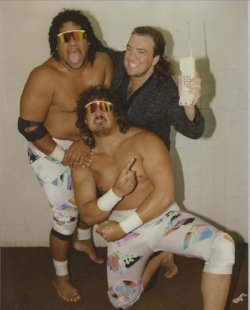
The Samoan Swat Team with Paul Heyman.
Another highlight for Rikishi was his teams’ participation in Wrestlemania 9, which took place in Las Vegas, at Ceasars Palace. This was the first Wrestlemania that was held outdoors. The Headshrinkers took on their long-time foes, the Steiner Brothers. “It was hardcore,” said Rikishi. “The Steiners were hardcore before hardcore, you know what I mean? I enjoyed it. It was out there in Las Vegas. I remember how hot that damn mat was out there in Las Vegas. We were out there working against those bulls. That day I can easily remember that we all got together that we talked about going out there to steal the show. I think we did a hell of a job together. We just had chemistry with the Steiners. The Steiners were known as rough and rugged. That worked right up our alley. It was a fun match. They could go either way. They could work with you or they could shoot. I suggest you work with them.”
In 1995 the Headshrinkers came to an end and the WWE decide to repackage Rikishi. First he became the street smart guy who talked about his hard life on the streets of San Francisco. He was known at that time as Fatu and was always trying to help kids using his slogan “Make a difference”.
Soon after that persona failed to garner the attention of the masses he was made into the Sultan. The Sultan wore a mask that covered his nose and mouth and was managed by Bob Backlund and the Iron Sheik. At Wrestlemania 13, the Sultan took on The Rock for the Intercontinental title.
His most famous character was Rikishi, revealed to the wrestling world in 1999. “When Rikishi was born, it was an accident,” said Rikishi. “This character was presented to me by Vince McMahon and we kinda threw it together with creative services. They wanted it to be a spin-off of my late cousin. They wanted the thong and that type to be a shoot-type sumo wrestler. I didn’t want it to go the same route as Yoko. I wanted to have my own identity so we went back and forth and this is where the bleached-blond hair came out. The first sumo wrestler Samoan to have bleached-blond hair.”
Rikishi didn’t want this character to be a flash in the pan. He wanted it to last in the memories of the fans. “We wanted to do something different instead of the big bad tough Samoan that we are always portrayed as. I wanted to be a happy type of Samoan,” said Rikishi. “What would a sumo wrestler not do? He wouldn’t dance so we came up with the idea to bust a move and we tried it on all of the house shows. When that happened it kinda took off, I got a following. I was worried about how the fans were going to accept me coming out as this big 400-pounder in a thong, but it was the biggest pop when I took my skirt off that I ever heard in my entire career.”
Wrestlers are known for signature maneuvers and Rikishi’s has one that is certainly unique. A 400-pound Samoan wearing a thong in a wrestling ring was certainly eye catching, but what else could he do to make an impression? “Then when this old lady (in the crowd) told me to put my butt in somebody’s face, my opponent. I went to do that it was the biggest pop then. So with all of those ingredients at the house shows I utilized that on Monday Night Raw TV and Rikishi’s career just took off, sky rocketed.”
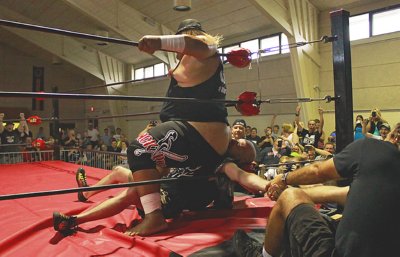
Rikishi delivers his stinkface to heel manager Jay Moore at a Crossfire Wrestling show in St. Catharines, Ontario. Photo by Ubel Photography & Design, Ubel.ca
With his new move, the stinkface, in his repertoire Rikishi was ready for the bright lights of the WWE. Soon after his debut he was teamed up with some unlikely allies the tag team of Scotty 2 Hotty and Grandmaster Sexy, Too Cool. “Being put together with Too Cool, they were heels at that time, but when we were put together our gig was mainly a fun type of crew,” said Rikishi. “We were happy. We could turn it on when we had to with the big bad Samoan or we could have a brawl with all three of us together. We had Scotty put the worm, we had Grandmaster come up with the Michael Jackson. Then we had this big Samoan trying to pop lock out there. It got over real big and the fans accepted it. The fans showed us some love and Rikishi was definitely a household name.”
During his time as Rikishi in the WWE he appeared in more Wrestlemanias, won the Intercontinental title and two more World Tag Team Championships. His tenure with the WE came to a close in 2004. At the WWE’s Raw 1000th episode, Rikishi returned to help take on Heath Slater. “It was very emotional,” said Rikishi. “Number one, I missed the fans all around the world. To be able to come back and revisit those memories. At the old school Raw it was great to see so many of my friends backstage. Most of all to come out and do what we do best together with your friends is very emotional.”
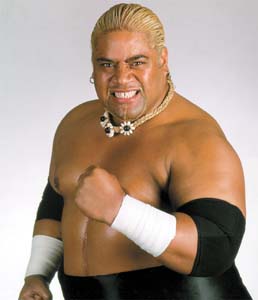
Rikishi in 2000.
Today Rikishi is still wrestling on the independent circuit and recently appeared at a Crossfire Wrestling show in St. Catharines, Ontario. Promoter and Crossfire wrestler Chris LaPlante loved having Rikishi at his event. “I think it’s fantastic to have an A-1, class act like Rikishi on our show,” said LaPlante. “He’s going to give the fans his best and keep the fans entertained.” At the conclusion of the show Rikishi was able to give the stinkface to the horrible, heel manager Jay Moore and sent the fans home happy.
Rikishi has been around the world with wrestling. He comes from a family that is deep in wrestling tradition. From his days as a young rookie in Montreal he has grown into a legend of the sport who is beloved by the fans. “I just want to send a shoutout to the fans out there across the world,” said Rikishi in parting. “I miss you all out there. Thank you for supporting me and the Samoan dynasty. I actually continue to support my sons out there, the Usos, Jimmy and Jay and also my cousin Roman Reigns. The Samoan dynasty appreciates all of your love and support and I hope you guys are proud of what we have given throughout the years in pro wrestling.”
RELATED LINK
Caleb Smith and Rikishi bonded over the fact that they both have twins. Bruno Sammartino has twins too, but he thought Smith was wacky. Catch Crossfire Wrestling on September on September 21st at the Merritton Community Centre in St. Catharines, Ontario featuring former UFC champion Dan Severn.
